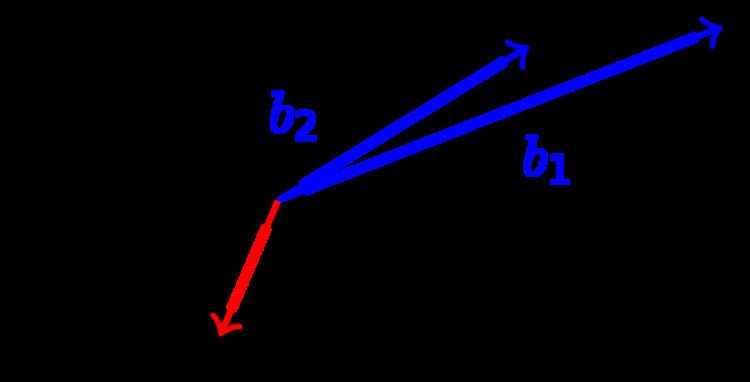 | ||
In computer science, lattice problems are a class of optimization problems on lattices. The conjectured intractability of such problems is central to construction of secure lattice-based cryptosystems. For applications in such cryptosystems, lattices over vector spaces (often
Contents
- Shortest vector problem SVP
- Known results
- GapSVP
- Closest vector problem CVP
- Relationship with SVP
- Sphere decoding
- GapCVP
- Shortest independent vectors problem SIVP
- Bounded distance decoding
- Covering radius problem
- Shortest basis problem
- Use in cryptography
- References
For all the problems below, assume that we are given (in addition to other more specific inputs) a basis for the vector space V and a norm N. The norms usually considered are L2. However, other norms (such as Lp) are also considered and show up in a variety of results. Let
Shortest vector problem (SVP)
In SVP, a basis of a vector space V and a norm N (often L2) are given for a lattice L and one must find the shortest non-zero vector in V, as measured by N, in L. In other words, the algorithm should output a non-zero vector v such that
In the
Known results
The exact version of the problem is only known to be NP-hard for randomized reductions.
By contrast, the equivalent problem with respect to the uniform norm is known to be NP-hard
Approach techniques: Lenstra–Lenstra–Lovász lattice basis reduction algorithm produces a "relatively short vector" in polynomial time, but does not solve the problem. Kannan's HKZ basis reduction algorithm solves the problem in
GapSVP
The problem
Yet another version of the problem is
Closest vector problem (CVP)
In CVP, a basis of a vector space V and a metric M (often L2) are given for a lattice L, as well as a vector v in V but not necessarily in L. It is desired to find the vector in L closest to v (as measured by M). In the
Relationship with SVP
The closest vector problem is a generalization of the shortest vector problem. It is easy to show that given an oracle for
The reduction from
Known results
Goldreich et al. showed that any hardness of SVP implies the same hardness for CVP. Using PCP tools, Arora et al. showed that CVP is hard to approximate within factor
Sphere decoding
The algorithm for CVP, especially the Fincke and Pohst variant, have been used for data detection in multiple-input multiple-output (MIMO) wireless communication systems (for coded and uncoded signals). In this context it is called sphere decoding due to the radius used internal to many CVP solutions.
It has been applied in the field of the integer ambiguity resolution of carrier-phase GNSS (GPS). It is called LAMBDA method in that field.
GapCVP
This problem is similar to the GapSVP problem. For
Known results
The problem is trivially contained in NP for any approximation factor.
Schnorr, in 1987, showed that deterministic polynomial time algorithms can solve the problem for
In 1993, Banaszczyk showed that
For lower bounds, Dinur et al. showed in 1998 that the problem is NP-hard for
Shortest independent vectors problem (SIVP)
Given a lattice L of dimension n, the algorithm must output n linearly independent
In the
Bounded distance decoding
This problem is similar to CVP. Given a vector such that its distance from the lattice is at most
Covering radius problem
Given a basis for the lattice, the algorithm must find the largest distance (or in some versions, its approximation) from any vector to the lattice.
Shortest basis problem
Many problems become easier if the input basis consists of short vectors. An algorithm that solves the Shortest Basis Problem (SBP) must, given a lattice basis
The approximation version
Use in cryptography
Average case hardness of problems forms a basis for proofs-of-security for most cryptographic schemes. However, experimental evidence suggests that most NP-hard problems lack this property: they are probably only worst case hard. Many lattice problems have been conjectured or proven to be average-case hard, making them an attractive class of problems to base cryptographic schemes on. Moreover, worst-case hardness of some lattice problems have been used to create secure cryptographic schemes. The use of worst-case hardness in such schemes makes them among the very few schemes that are very likely secure even against quantum computers.
The above lattice problems are easy to solve if the algorithm is provided with a "good" basis. Lattice reduction algorithms aim, given a basis for a lattice, to output a new basis consisting of relatively short, nearly orthogonal vectors. The Lenstra–Lenstra–Lovász lattice basis reduction algorithm (LLL) was an early efficient algorithm for this problem which could output an almost reduced lattice basis in polynomial time. This algorithm and its further refinements were used to break several cryptographic schemes, establishing its status as a very important tool in cryptanalysis. The success of LLL on experimental data led to a belief that lattice reduction might be an easy problem in practice. However, this belief was challenged when in the late 1990s, several new results on the hardness of lattice problems were obtained, starting with the result of Ajtai.
In his seminal papers, Ajtai showed that the SVP problem was NP-hard and discovered some connections between the worst-case complexity and average-case complexity of some lattice problems. Building on these results, Ajtai and Dwork created a public-key cryptosystem whose security could be proven using only the worst case hardness of a certain version of SVP, thus making it the first result to have used worst-case hardness to create secure systems.
